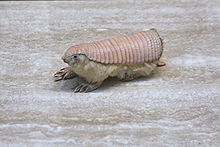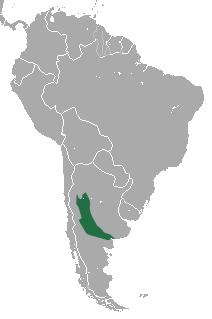| Pink fairy armadillo[1] | |
|---|---|

| |
| Scientific classification | |
| Domain: | Eukaryota |
| Kingdom: | Animalia |
| Phylum: | Chordata |
| Class: | Mammalia |
| Order: | Cingulata |
| Family: | Chlamyphoridae |
| Subfamily: | Chlamyphorinae |
| Genus: | Chlamyphorus Harlan, 1825 |
| Species: | C. truncatus
|
| Binomial name | |
| Chlamyphorus truncatus Harlan, 1825
| |

| |
| Pink fairy armadillo range | |
The pink fairy armadillo (Chlamyphorus truncatus) is the smallest species of armadillo, first described by Richard Harlan in 1825.[3] This solitary, desert-adapted animal is endemic to the deserts and scrub lands of central Argentina.[4] The pink fairy armadillo is closely related to the only other fairy armadillo, the greater fairy armadillo.
Pink fairy armadillos have small eyes, silky yellowish white fur, and flexible dorsal shells that are attached to their bodies solely by thin dorsal membranes. Their spatula-shaped tails protrude from vertical plates at the blunt rear of their shells. They exhibit nocturnal and solitary habits and feed themselves largely on insects, worms, snails, and various plant parts. The pink fairy armadillo has a unique ability to bury itself in a matter of seconds, using its specialized claws to dig into sandy or loamy soils. This behavior helps protect the armadillo from predators and extreme temperatures, as well as conserve moisture in its arid habitat.[5]
The conservation status of pink fairy armadillos is uncertain, and it is listed as Data Deficient by the IUCN Red List of Threatened Species. The decline in population for this species has generally been attributed to farming activities and predators including domestic dogs and cats.[6] Pink fairy armadillos are found less commonly than they were a few decades ago, and the field sightings have been rare and incidental.[7]
Individuals caught in the wild had a tendency to die during or a couple days after transport from their natural habitat to captive facilities. There is a sole record for the longevity of a pink fairy armadillo that was held in captivity more than four years; however, that particular case lacks scientific description.[7] Armadillos' evolutionary distinctiveness, combined with their restricted geographic range, ongoing threats, and rarity, make conservation extremely urgent for these species.[3]
- ^ Gardner, A. (2005). Wilson, D.E.; Reeder, D.M. (eds.). Mammal Species of the World: A Taxonomic and Geographic Reference (3rd ed.). Johns Hopkins University Press. p. 96. ISBN 978-0-8018-8221-0. OCLC 62265494.
- ^ Superina, M.; Abba, A.M. & Roig, V.G. (2014). "Chlamyphorus truncatus". The IUCN Red List of Threatened Species. 2014. IUCN: e.T4704A47439264. doi:10.2305/IUCN.UK.2014-1.RLTS.T4704A47439264.en.
- ^ a b Delsuc, F.; Superina, M.; Tilak, M.-K.; Dousery, E.; Hassanin, A. (2012). "Molecular phylogenetics unveils the ancient evolutionary origins of the enigmatic fairy armadillos". Molecular Phylogenetics and Evolution. 62 (2): 673–680. doi:10.1016/j.ympev.2011.11.008. PMID 22122941. S2CID 42162998.
- ^ Douglas, Sara. "Chlamyphorus truncatus (pink fairy armadillo)". Animal Diversity Web. Retrieved 16 March 2024.
- ^ Cite error: The named reference
Pallardywas invoked but never defined (see the help page). - ^ Cite error: The named reference
Borghi, Carlos E. 2011was invoked but never defined (see the help page). - ^ a b Cite error: The named reference
husbandrywas invoked but never defined (see the help page).
